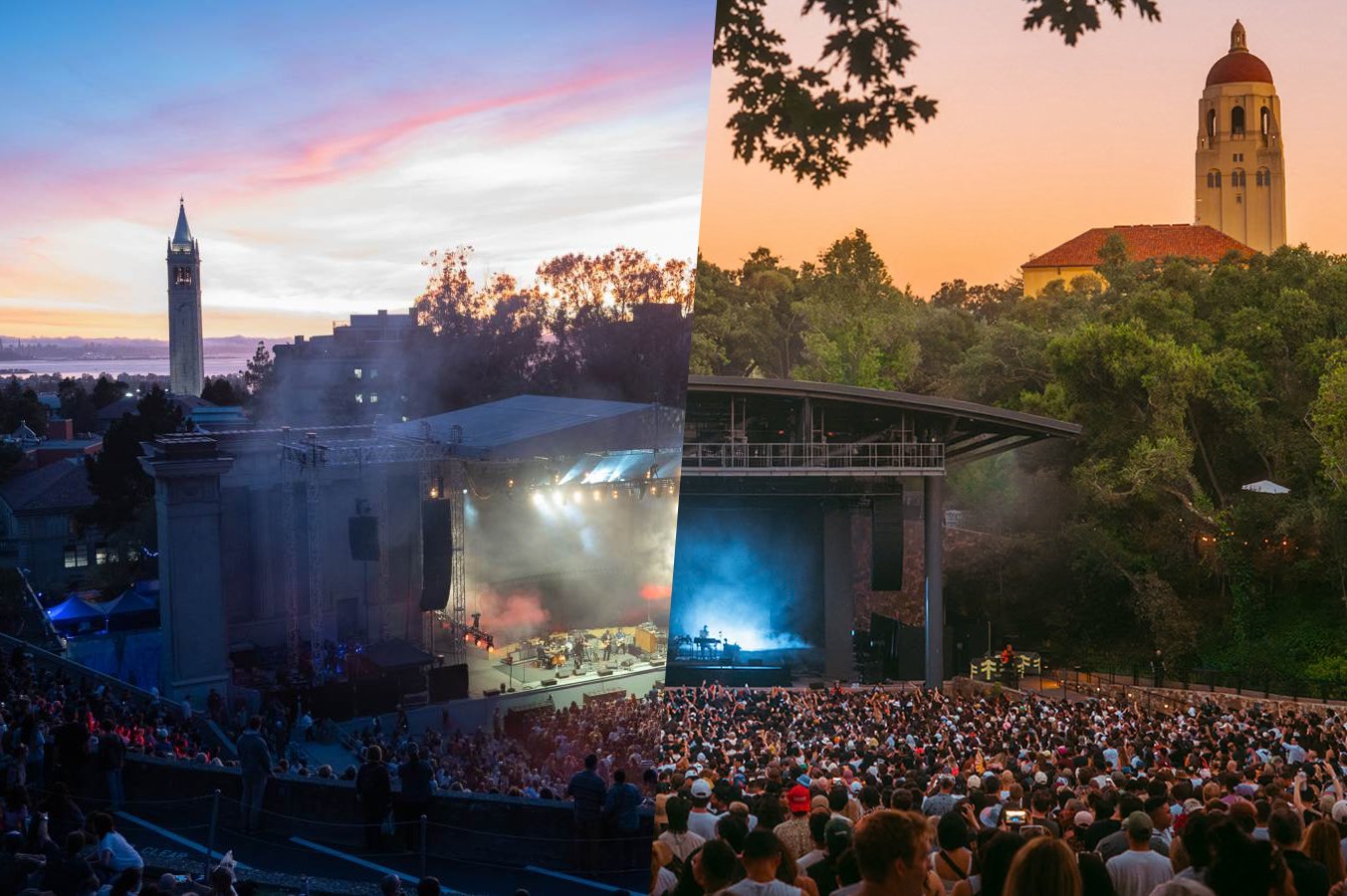The booming voice of the Big Game announcer seems to pierce through the November air: “Today, houses stand divided, and families split apart.” The division isn’t exclusive to literal houses, though. What about the audiences, families forged through musical bonds, standing in the houses of theaters across the Bay?
Both UC Berkeley and Stanford students frequent concerts, sometimes near their own campuses and sometimes crossing the Bay to listen to a particular artist. In honor of the football spirit, prepare to meet the star-studded roster of music venues each school has to offer.
Match-up #1: The Comfy and Cozy
Playing for Stanford University: The Arbor
Playing for UC Berkeley: The Backroom
The Arbor is Stanford’s worst kept unintentional secret. The Arbor, whose Instagram bio simply reads “student run student music,” is a production company on-campus which puts on student music shows in the patio behind Tresidder Memorial Union. Many assume that the guitar player, or the salsa music group, or the DJ playing near Treehouse is there by default, but nope — that is Stanford’s one and only The Arbor!
In winters, The Arbor moves indoors to CoHo’s miniature stage, giving the cafe a cozy vibe no matter what music is playing. Many students will take off their noise canceling headphones and vibe to the music as they work, or simply put away their work and enjoy the moment. However, this cozy, indoor vibe lasts all year at UC Berkeley’s The Back Room!
The Back Room, opened by UC Berkeley local musician Sam Rudin in 2016, occupies what used to be The Freight and Salvage: a music venue “deeply rooted in that aspect of Berkeley’s culture that embraced freedom, justice, acceptance, collaboration, and innovation.” Open to all ages, the venue, according to its website, strives to keep the “cozy ambience” of The Freight and Salvage as one dedicated to “acoustic music.” Similarly to The Arbor, there is no rule against alcohol at performances, but the venue itself sells limited pre-packaged snacks, as well as water and soft drinks.
Stanford Highlights: On-campus, music venue in dining area, student-led, indoor-outdoor.
UC Berkeley Highlights: Off-campus, strictly music venue, independent, indoors.
Match-up #2: Swimming in Sound
Playing for Stanford University: Bing Concert Hall
Playing for UC Berkeley: The Cornerstone
Judging by size is not always a safe bet, as UC Berkeley’s The Cornerstone demonstrates. Though its 13,000 square feet are dwarfed by Stanford’s Bing Concert Hall’s 112,600 square feet, its sound system is one of the best in the Bay area, with a Three-Way SUBCOMPACT Live Array System. The Cornerstone, whose large stage holds over 500 people, is usually a standing-room only venue, except for the VIP Mezzanine with views of the entire space.
In contrast, Bing Concert Hall’s 842 seats are surrounded by an acoustic system designed by Yasuhisa Toyota of Nagata Acoustics. In case the name doesn’t ring a bell, that’s the same team that worked on the sound system in the Walt Disney Concert Hall in Los Angeles, Calif. Both venues opened in the same decade, with The Cornerstone having opened in 2017 and Bing Concert Hall having opened in 2013.
Though both venues are state-of-the-art, their line-ups of artists and performers vary. While Bing Concert Hall is no stranger to the Stanford Symphony Orchestra, the Stanford Laptop Orchestra (SLOrk) and the San Francisco Ballet Company to name a few, you’d be hard pressed to find these performances in The Cornerstone. Rather, The Cornerstone’s upcoming performances include more casual performances, such as singer-songwriter Donna Missal on Dec. 8, pop-funk musician Molly Grace on Dec. 11 and “Gimme Gimme Disco,” an ABBA inspired dance party on Dec. 28.
Stanford Highlights: Seating available, performing arts and music performances, on-campus.
UC Berkeley Highlights: Standing room only, music performances and dance parties, off-campus.
Match-up #3: It’s all Greek to me… well, kinda.
Playing for Stanford University: Frost Amphitheater
Playing for UC Berkeley: The Greek Theater
In early September, dozens of us migrated to UC Berkeley to see Gracie Abrams. In early October, dozens of UC Berkeley bears made their way to The Farm to bear witness to Clairo’s Charmed Tour. The artists that these venues bring are big, and Stanford and Berkeley might well be evenly matched here.
The Greek Theater at UC Berkeley, opened in 1903, takes advantage of the Bay’s extended summer months in order to host a variety of artists and personalities. Aside from Gracie Abrams, The Greek has housed artists like Bob Dylan, Adele and John Legend in its past line-ups. Though amphitheaters are indeed a Greek invention, The Greek isn’t just named “The Greek” because of the origins of theater. Built with funds donated by William Randolph Hearst, The Greek is inspired by Greek architecture, with some Roman touches thrown in.
Frost Amphitheater, in contrast, wasn’t inspired by any particular civilization, but rather bases its design on the rolling foothills that surround Stanford’s campus. Though Frost opened in 1937, it sat largely dormant between the 1980’s and the 2010’s, as it was deemed “not entirely suitable for large-scale events.” Reopened in 2019, Frost has hosted artists Mitski, Glass Animals, Duke Ellington and Louis Armstrong.
Stanford and UC Berkeley Highlights: Outdoor venues, on-campus, incredibly popular artists.
Conclusion:
The venues have battled it out, and the facts above are what they are. Just as beauty is in the eye of the beholder, the decision of which music one prefers is incredibly subjective. Standing room or seated, mosh pit or couches, the choice is completely yours. But, if you still can’t decide whether UC Berkeley or Stanford’s music venues have your heart, then take this into account: Coldplay chose Stanford’s campus to host their Music of the Spheres World Tour, not Berkeley’s.
Editor’s Note: This article is a review and includes subjective thoughts, opinions and critiques.
